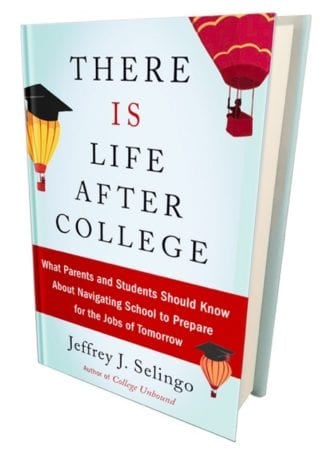When our kids are accepted to college it is easy to feel a sigh of relief that they are on their way. But these are the life’s four quickest years and it soon becomes clear that finding life after college is dependent on so many choices students make in and out of the classroom, starting with the choice of which college to attend.
Jeffrey Selingo, author of the new There Is Life After College: What Parents and Students Should Know About Navigating School to Prepare for the Jobs of Tomorrow has taken a deep dive into the transition from college to the workplace. He tries to dispel some of the misconceptions and fears of what happens when our kids, as early as sophomore year, venture into the job market.
He traces the path of what he calls Sprinters, Wanderers or Stragglers and shows, from a large survey he conducted for the book, what decisions and actions students take, from high school through their college years and beyond, to find themselves in each of these groups. This is invaluable insight for parents and students thinking about decisions like where to go to college and what to major in, summer jobs and financing an education.
The paths into the job market are very different than those many parents of college kids faced decades ago and this book lets parents, and their students, hear from corporate CEOs on the qualifications and, in many cases, more important intangible skills that recruiters seek.
Selingo emphasises the importance of what students do in college over where they go to college. Do they spend their time partying or throwing themselves into extracurricular activities that teach leadership and people skills? Do they coast through the easiest classes or find subjects that challenge their critical thinking and teach them new skills.
In many cases college does not prepare young adults for the workplace, Selingo argues. College is structured with semesters, syllabuses, and expectations clearly delineated by professors. Students avoid Friday classes, three-day weekends are largely the norm and summer and semester breaks are lengthy. Selingo argues that students have spent too much of their time in activities laid out for them by others with most decisions predetermined. “Recruiters repeatedly told me that today’s college graduates don’t have enough experience learning from failures or hardships, particularly on a job.“
For parents, Selingo’s account of the internship process and its paramount importance in securing a job after graduation might be the biggest surprise, unless of course you are a parent who works with interns. While 30 years ago we might have thought of summer as a time to make some money and work on your tan and, perhaps, the summer before senior year try to gain some relevant work experience, internships have become an essential stepping stone to life after college.
Selingo paints a bleak picture with almost half of college graduates underemployed, meaning holding down a job that does not require a bachelor’s degree.
If you’re a parent desperately waiting for your kids to graduate from college so you won’t have to support them financially anymore, think again. Maybe you’re a child of the 1970s and 1980s, when college graduates, on average, reached financial independence by the time they turned twenty-six years old. Today, college graduates don’t hit that mark until their thirtieth birthday.
But the real value in this book is that it shows how young adults, starting in high school, can take steps to escape this fate.
Interview with author Jeffrey Selingo, author of There IS Life After College
G&F: What is so important that students learn in summer jobs as early as high school?
JS: We have fewer teenagers working today than at anytime since the 1940s. There are plenty of reasons for that. At the middle and upper income levels it’s because students are busy doing other things conducting community service and playing sports and other types of activities. But one thing I heard from employers while writing the book is that for the most part students, even if they have internships in college, have their first day-to-day work experience as a salaried employee is after college.
And what ends up happening is that they approach the job much like they approach school. As the head of recruiting for Enterprise Rent-a-car said they had been “syllabused” through their lives. Something was planned for them by parents or teachers or others, their learning was directed for them largely by teachers.
A summer or school term job teaches you how to show up on time. It teaches you how to work with people from different backgrounds and different generations. It shows you the value of work and the cadence of a day, a week or month in a job which is very different from the cadence of a college or university experience.
G&F: Thinking about the job market, what factors should high school students consider when selecting a college?
JS: Outside of the classroom learning opportunities are more important than ever before and you are able to get these in more urban areas where there is more opportunity for employment which allow you to have that mashup, as I call it, of the experience. You are going to classes one day and working the next day. Or you are going to classes in the morning and working in the afternoon at an internship. More urban areas offer you those opportunities that students used to only get in the summer or by taking a semester off or during a January term. They are now getting this experience during the school year.
The advantage of colleges located near employment goes beyond internships and allows you to have networking on and off campus. We used to think that sending kids off for four years and isolating them was the best way to educate them. Well the best way to educate them right now is to have mix of the liberal arts and occupational arts and the best way you get that professional experience is by attending a school where you have greater access to those opportunities.
G&F: Why don’t students get the experience they need in college?
JS: Success requires you to deal with and navigate ambiguity. Unfortunately while the workplace is becoming more ambiguous, colleges and universities and how they put together their curriculum, is becoming less ambiguous.
You now go to college and know who your roommate is before you get there. You meet your classmates on Facebook and other places before you arrive on campus. In larger universities, the presences of advising, helped by a software using predictive analytics, helps you select majors and courses that you will do well in. It doesn’t allow you to explore or deal with failure.
G&F: What has changed about the way college graduates find jobs?
One of the big findings of the book for me was that an increasing number of employers are hiring their new employees from their intern pools and not from recruiting on campus. The internship has become more critical than ever before. Often multiple internships starting in freshman, sophomore and junior year, not just junior year, can lead to a job after college. The competition is pretty high in the summer when everyone is trying to do an internship but if you go to school in an urban center you have a much better opportunity to mix in these opportunities with your academic calendar when there is less competition for positions.
Related:
Dear Parent of Newly Admitted Freshman
Our favorite off to school essays can be found here
Jeff Selingo is the author of author of There Is Life After College: What Parents and Students Should Know About Navigating School to Prepare for the Jobs of Tomorrow. He has also written College (Un)Bound: The Future of Higher Education and What It Means for Students, a New York Times bestselling education book in 2013, and MOOC U: Who Is Getting the Most Out of Online Education and Why.
A regular contributor to the Washington Post, Jeff is a special advisor and professor of practice at Arizona State University and a visiting scholar at Georgia Tech’s Center for 21st Century Universities. He is the former top editor of the Chronicle of Higher Education, where he worked for 16 years in a variety of reporting and editing roles.










